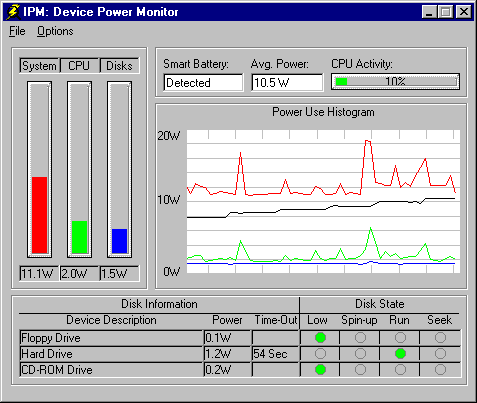|
|
|
|
|
|
|
|
![]()
The Device Power Monitor (DPM)
The Device Power Monitor is designed to give an ISV or OEM a more detailed analysis tool for
determining the impact of their software design on specific platform subsystems. Presently, the
DPM subsystem supports analysis of the CPU and rotating media, such as a floppy drive, a hard
drive and a CD-ROM drive.

The Device Power Monitor
The CPU Activity Gauge
The DPM subsystem has the CPU activity gauge in the upper-right corner of the display. You read this gauge exactly like the gauge in the main IPM window. Immediately to the left of the CPU activity gauge are text boxes that display whether a Smart Battery has been found on this system and an average power display.The Device Power Gauges
The left side of the window has three gauges labeled System, CPU and Disks. These gauges display power use by the entire system and separate the CPU and rotating media into two separate power measurements. On a Smart Battery supported system, the System gauge is a very accurate measurement of power usage. The CPU and Disks gauges are calculated power use numbers based upon the observed behavior of your system.The Power Use Histogram
The Power Use Histogram tracks and displays the three Device Power Gauges numbers and the Average Power number.The Disk Information Display
The Disk Information Display area has a line entry for each instance of rotating media found on the system. This display is limited to at most one floppy, one hard drive and one CD-ROM drive. If your system has more than one of any of these devices, only one of each type will be displayed. Each entry contains the Device Name, a power reading based upon the disk's present state, a time-out value and a disk state area. In most mobile systems, disks can be described as being in roughly one of four possible states:- Low – Drive is spun-down
- Spin-Up – Drive is transitioning from Low to Run/Seek
- Run – Drive is spinning the platter but not performing a read or write operation
- Seek – Drive is moving the head to perform a read or write operation
Each device state carries with it an associated power consumption amount. This is normally
described in the drives data sheet.
Calibrating the Device Power Monitor
The Device Power Monitor will work on systems with and without Smart Battery support, but
the system power numbers are more accurate if you have a Smart Battery. If you have a
Smart Battery and it is detected by the software, you will be prompted to perform a system
calibration to ensure the most reliable estimation possible for the CPU and rotating media. If you
do not have a Smart Battery System, the DPM subsystem will estimate power consumption based
upon your processor family and speed.
Running the Device Power Monitor
Once you have configured the DPM subsystem to understand your particular system, you can
run the DPM subsystem and then run your application. On a Smart Battery
enabled system, you will need to remove AC power and run on battery. As your application uses
more CPU bandwidth, you will see a subsequent rise in the power used by the CPU. If your
application often causes the rotating media spin-up, then this also will be reflected by the
DPM display.
* Legal Information © 1998 Intel Corporation